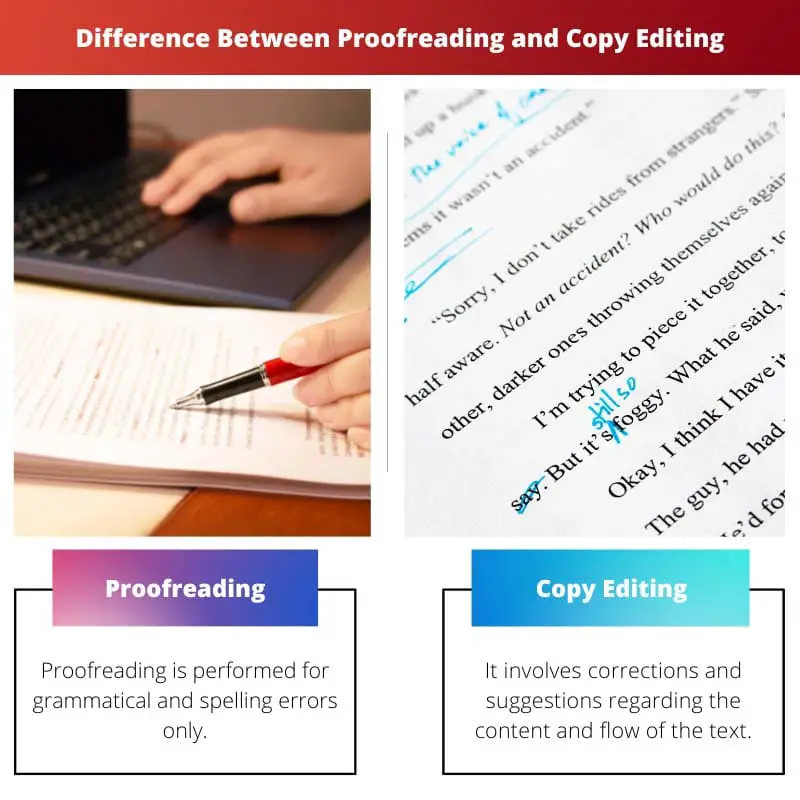Proofreading and copy-editing are professional editing services that can be required in various stages of a project.
These will help you ensure your business or academic work is error-free and your intended message is delivered to your audience. There are a few key differences between proofreading and copy editing.
Key Takeaways
- Proofreading involves checking a document for spelling, grammar, punctuation, and formatting errors.
- Copy editing involves document review for clarity, accuracy, style, tone, and consistency.
- Proofreading is the final stage of editing before publication, while copy editing is a more comprehensive process that occurs earlier in the editing process.
Proofreading vs Copy Editing
The process of checking the document is called proofreading. The checking of documents includes spelling and grammar checking. The format of the document is also checked in proofreading. In copy editing, the text is checked to determine whether it contains any errors or not. Content quality is also checked in copy editing.

Proofreading is the process of reading over a document to ensure spelling, grammar, punctuation, format, and accuracy. It is a great skill for anyone to have because it shows attention to detail.
It can also be used to maintain consistency throughout a document.
Copy editing refers to reviewing a text and ensuring that it is free of errors and matches the brand style and voice.
Copy editing is the act of overseeing the writing of certain pieces to ensure the quality of the content is good and the writer’s intentions are made clear.
Comparison Table
| Parameters of Comparison | Proofreading | Copy Editing |
|---|---|---|
| Meaning | Proofreading is performed for grammatical and spelling errors only. | It involves corrections and suggestions regarding the content and flow of the text. |
| Spelling | Proofreading involves checking for any mistakes, typos, and spelling errors. | A copy editor will check if a product is meeting its brand image, tone, and voice. |
| Grammar | Proofreaders improve the grammatical errors of writing. | Copy editors improve grammar as well as other aspects of the writing. |
| Style | Proofreaders are not considered with the style of the writing. | Copy editors are focused on the style of the writing. |
| Creativity | There is no scope for creative writing in proofreading. | Copy editing requires a creative writing touch to ensure the brand is well represented and liked. |
What is Proofreading?
Proofreading is when a person or a group of people check for errors in a document to make sure it’s free of mistakes. Proofreaders work on documents of all types, from blog posts to books.
While there are tools that can help forensic writers check for errors, a lot of proofreaders will use their eyes to catch mistakes and ensure the highest quality document.
Proofreading is when an editor reads a document and checks for errors in spelling, grammar, punctuation, etc. so that when it’s published, it is as error-free as possible.
Proofreading is really important because you might miss errors that are obvious to other people. Proofreading is the final step in the editing process.
Proofreading is a process of editing written material for errors in spelling, grammar, punctuation, word choice, sentence structure, and word forms.
In other words, it is the process of checking facts, figures, tables, etc., for accuracy and defects.
It is easy and only takes a few minutes, so definitely worth the time. When you proofread, you look for spelling, punctuation, and grammar errors.
When you have gone over your article, paragraph, or essay and it is ready to be published, you should also have a second person proofread it to make sure that everything is correct.

What is Copy Editing?
Copy editing is the process of checking documents to ensure they’re free from errors, inconsistencies, and other errors that could be distracting to the reader.
This process is different from proofreading, which only ensures the document is free of spelling and grammar errors.
During copy-editing, you will ensure that sentences and paragraphs flow together nicely, make sure the writing style is consistent throughout the document and that the document is free of factual errors like typos and missing words.
Not only can these errors distract readers, but they can also damage your brand’s reputation if they’re present on official documents or company websites.
A copy editor is someone who reads your written document and edits it for errors. They do this so your document is more clear, easier to read, and more attractive.
There are many different types of editing, but copy editing involves reviewing the document for spelling and grammar errors, making sure the meaning is clear, and comparing the document to other material the reader is likely familiar with.
Some copy editors go beyond what is considered grammatical correctness and will attempt to make the copy clear and more fun to read. This is called copy editing for style.

Main Differences Between Proofreading and Copy Editing
- Proofreading is the first step in the editing process, and copy editing goes beyond proofreading.
- A proofreader is responsible for correcting spelling and grammatical errors, while a copy editor is responsible for everything from tracking the correct usage of words and phrases to identifying redundancies and eliminating errors in fact or logic.
- Proofreading is done to ensure the correctness of your writing, while copy editing is done to ensure the quality of your writing as well as to ensure style and grammar.
- Proofreading is performed before copy-editing a written piece.
- Compared to proofreading, copy editing is a bit more complicated as it involves a deeper document analysis.
